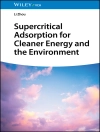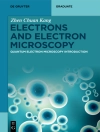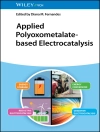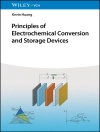This volume in the ‘Advances in Electrochemical Sciences and Engineering’ series focuses on problem-solving, illustrating how to translate basic science into engineering solutions.
The book’s concept is to bring together engineering solutions across the range of nano-bio-photo-micro applications, with each chapter co-authored by an academic and an industrial expert whose collaboration led to reusable methods that are relevant beyond their initial use.
Examples of experimental and/or computational methods are used throughout to facilitate the task of moving atomistic-scale discoveries and understanding toward well-engineered products and processes based on electrochemical phenomena.
表中的内容
Series Preface xi
Preface xiii
1 Introductory Perspectives 1
A. Paul Alivisatos and Wojciech T. Osowiecki
References 4
2 The Joint Center for Energy Storage Research: A New Paradigm of Research, Development, and Demonstration 7
Thomas J. Carney, Devin S. Hodge, Lynn Trahey, and Fikile R. Brushett
2.1 Background and Motivation 7
2.2 Lithium-ion Batteries: Current State of the Art 8
2.3 Beyond Li-Ion Batteries 9
2.4 JCESR Legacies and a New Paradigm for Research 9
2.5 The JCESR Team 13
2.6 JCESR Operational Tools 16
2.7 Intellectual Property Management 17
2.8 Communication Tools 17
2.9 JCESR Change Decision Process 17
2.10 Safety in JCESR 19
2.11 Battery Technology Readiness Level 20
2.12 JCESR Deliverables 21
2.13 Scientific Tools in JCESR 22
2.14 Techno-economic Modeling 23
2.14.1 Techno-economic Modeling of a Metal–Air System for Transportation Applications 23
2.14.2 Techno-economic Modeling of Flow Batteries for Grid Storage Applications 25
2.15 The Electrochemical Discovery Laboratory 27
2.15.1 The Effect of Trace Water on Beyond Li-ion Devices 27
2.15.2 Stability of Redox Active Molecules 28
2.16 Electrolyte Genome 28
2.16.1 Screening of Redox Active Molecules for Redox Flow 29
2.16.2 Examination of Multivalent Intercalation Materials 30
2.17 Combining the Electrolyte Genome with Techno-economic Modeling 31
2.18 Prototype Development 31
2.19 Legacy of JCESR 33
2.20 Conclusion 34
Acknowledgments 34
References 34
3 Determination of Redox Reaction Mechanisms in Lithium–Sulfur Batteries 41
Kevin H.Wujcik, Dunyang R.Wang, Alexander A. Teran, Eduard Nasybulin, Tod A. Pascal, David Prendergast, and Nitash P. Balsara
3.1 Basics of Lithium–Sulfur Chemistry 41
3.2 End Products of Electrochemical Reactions in the Sulfur Cathode 44
3.3 Intermediate Products of Electrochemical Reactions in the Sulfur Cathode 45
3.3.1 Reactions of S8 45
3.3.2 Reactions of Li2S8 46
3.3.3 Reactions of Li2S4 47
3.3.4 Reactions of Li2S2 48
3.3.5 Production of Radical Anions 49
3.4 Fingerprinting Lithium Polysulfide Intermediates 49
3.4.1 X-ray Absorption Spectroscopy 50
3.4.2 Electron Paramagnetic Resonance Spectroscopy 53
3.4.3 UV–Vis Spectroscopy 54
3.4.4 Raman Spectroscopy 57
3.4.5 Nuclear Magnetic Resonance Spectroscopy 57
3.5 In Situ Spectroscopic Studies of Li–S Batteries 58
3.5.1 X-ray Absorption Spectroscopy 58
3.5.2 Electron Paramagnetic Resonance Spectroscopy 59
3.5.3 UV–Vis Spectroscopy 60
3.5.4 Raman Spectroscopy 60
3.5.5 Nuclear Magnetic Resonance Spectroscopy 61
3.6 Practical Considerations 62
3.7 Concluding Remarks 64
Acknowledgment 68
References 68
4 From the Lab to Scaling-up Thin Film Solar Absorbers 75
Hariklia Deligianni, Lubomyr T. Romankiw, Daniel Lincot, and Pierre-Philippe Grand
4.1 Introduction 75
4.2 State-of-the-art Electrodeposition for Photovoltaics 79
4.2.1 Electrodeposited Cu In Ga Se2 (CIGS) 80
4.2.1.1 Metal Layers 80
4.2.1.2 Electrodeposition of Copper 81
4.2.1.3 Electrodeposition of Indium 82
4.2.1.4 Electrodeposition of Gallium 85
4.2.2 Single Cu—In—Ga—Se—O Multicomponent Chemistries 89
4.2.2.1 Cu—In—Se Co-deposition 89
4.2.2.2 Cu—In—Ga—Se Co-deposition 91
4.2.2.3 Cu—In—Ga—O Co-deposition 92
4.2.2.4 Cu—In—Ga Co-deposition 93
4.2.3 Annealing Methods 93
4.2.4 Fabrication of Solar Cells 95
4.3 Electrodeposited Cu2Zn Sn(Se, S)4 (CZTS) and Emerging Materials 97
4.3.1 Cu2Zn Sn(Se, S)4 (CZTS) 97
4.4 From the Rotating Disk to the Paddle Cell as a Scale-up Platform 99
4.4.1 Introduction to Scale-up 99
4.4.2 Entirely New Solution Agitation Method 100
4.4.3 The Paddle Agitation Technique Is More Readily Scalable 101
4.4.4 Electrical Contact Between the Thin Seed Layer and the Source of Current 103
4.4.5 Previous Scale-up of the Paddle Cell 103
4.4.6 Scale-up of the Paddle Cell to 15 cm× 15 cm 104
4.4.7 Scale-up of the Paddle Cell to 30 cm× 60 cm 107
4.4.8 Improving Within-Wafer Uniformity, Reproducibility, and Demonstration of Scalability 108
4.4.8.1 Within-Wafer Uniformity 108
4.4.8.2 Wafer-to-Wafer Reproducibility 109
4.5 Scaling-up to 60 cm× 120 cm from Tiny Electrodes to Meters 110
4.5.1 A 1 m2 min−1 Continuous Industrial Scale 110
4.5.2 Bath Control 116
4.5.2.1 Insoluble Anode 118
4.5.2.2 Soluble Anode 118
4.5.2.3 Bath Maintenance and Reproducibility and Steady-State Operation 119
4.6 Conclusions 121
Acknowledgments 122
References 123
5 Thin-film Head and the Innovator’s Dilemma 129
Keishi Ohashi
5.1 Introduction 129
5.2 Thin-film Head Technology 130
5.2.1 Magnetic Properties for HDD 130
5.2.2 Permalloy 130
5.2.3 Thin-film Head 132
5.2.4 Magnetic Domain Noise 133
5.3 Data Storage Business in Japan 137
5.3.1 Magnetic Thin-films for HDD in the 1980s 137
5.3.2 Use of Optics 138
5.3.3 High-Moment Head Core Material 138
5.3.4 High-Ms Write Heads 141
5.4 The Innovator’s Dilemma 142
5.4.1 Thin-film Head is not Disruptive 142
5.4.2 Small HDD 143
5.4.3 MR Head 144
5.4.4 GMR Head 145
5.5 TMR Head 147
5.5.1 Infinite MR Ratio 147
5.5.2 Suspicions Surrounding the TMR Head 147
5.5.3 Low-Resistance TMR Head 148
5.5.4 MGO:The Final Push 150
5.5.5 Exploring New Markets 151
5.6 Discussion 151
Acknowledgments 152
References 153
6 Development of Fully-Continuous Electrokinetic Dewatering of Phosphatic Clay Suspensions 159
Rui Kong, Arthur Dizon, Saeed Moghaddam, and Mark E. Orazem
6.1 Introduction 159
6.1.1 Phosphatic Clay Suspensions 160
6.1.2 Industrial Scope 160
6.1.3 Why is Separation of Water from Clay Difficult? 161
6.2 Current Methods 162
6.2.1 Flocculation 162
6.2.2 Mechanical Dewatering 163
6.2.3 Electrokinetic Separation 163
6.3 Development of Dewatering Technologies for Phosphatic Clays 164
6.3.1 Lab-scale Batch Dewatering 165
6.3.2 Semi-continuous Operation to Recover Clear Supernatant 168
6.3.3 Semi-continuous Operation to Recover Solids 170
6.3.4 Continuous Operation 172
6.3.5 Energy and Power Requirements for All Prototypes Tested 175
6.4 Economic Assessment for On-site Implementation 179
6.4.1 Hydrogen Emission 179
6.4.2 Capital and Operation Costs 180
6.4.2.1 Power and Energy consumption for On-site Operations 181
6.4.2.2 Operation cost 181
6.4.2.3 Capital Cost 183
6.4.3 Results 184
6.5 Our Next Prototype: Dual-zone Continuous Operation 185
6.6 Conclusions 186
Acknowledgments 187
References 187
Contents ix
7 Breaking the Chemical Paradigm in Electrochemical Engineering: Case Studies and Lessons Learned from Plating to Polishing 193
E. Jennings Taylor, Maria E. Inman, Holly M. Garich, Heather A. Mc Crabb, Stephen T. Snyder, and Timothy D. Hall
7.1 Introduction 193
7.1.1 Perspective 194
7.2 A Brief Overview of Pulse Reverse Current Plating 196
7.2.1 Mass Transport Effects in Pulse Current Plating 198
7.2.2 Current Distribution Effects in Pulse Current Plating 200
7.2.3 Grain Size Effects in Pulse Current Plating 204
7.2.4 Current Efficiency Effects in Pulse Current Plating 205
7.2.5 Concluding Remarks for Pulse Current Plating 205
7.3 Early Developments in Pulse Plating 206
7.3.1 Leveling Without Levelers Using Pulse Reverse Current Plating 207
7.3.2 Ductility Without Brighteners Using Pulse Current Plating 210
7.4 Transition of Pulse Current Plating Concepts to Surface Finishing 211
7.4.1 Pulse Voltage Deburring of Automotive Planetary Gears 212
7.4.2 Transition to Pulse Reverse Voltage Electropolishing of Passive Materials 214
7.4.3 Sequenced Pulse Reverse Voltage Electropolishing of Semiconductor Valves 216
7.4.4 Pulse Reverse Voltage Electropolishing of Strongly Passive Materials 220
7.4.5 Pulse Reverse Voltage Electropolishing of Niobium Superconducting Radio Frequency Cavities 223
7.4.6 Transition Pulse Reverse Voltage Electropolishing to Niobium Superconducting Radio Frequency Cavities 226
7.5 Concluding Thoughts 232
Acknowledgments 233
References 234
8 The Interaction Between a Proton and the Atomic Network in Amorphous Silica Glass Made a Highly Sensitive Trace Moisture Sensor 241
Yusuke Tsukahara, Nobuo Takeda, Kazushi Yamanaka, and Shingo Akao
8.1 Unexpected Long Propagation of Surface Acoustic Waves Around a Sphere 241
8.2 Invention of a Ball SAWDevice and Application to Gas Sensors 243
8.3 Unexpected Fluctuations in the Output Signal of the Gas Sensor Leading to the Development of Trace Moisture Sensors 249
8.4 Sol–Gel Silica Film for the Trace Moisture Sensors 253
8.5 A Thermodynamic Model of Interaction of Water Vapor with Amorphous Silica Glass 254
8.6 Concluding Remarks 257
References 257
9 From Sensors to Low-cost Instruments to Networks: Semiconducting Oxides as Gas-Sensitive Resistors 261
David E.Williams
9.1 Overview 261
9.2 Basic Science of Semiconducting Oxides as Gas-Sensitive Resistors 266
9.2.1 Multiscale Modeling of Gas-Sensitive Resistors 266
9.2.1.1 Introduction 266
9.2.1.2 Effective Medium Model 1: Rationalization of Composition Effects on Response 268
9.2.1.3 Effective Medium Model 2: Diffusion–Reaction Effects on Response; Effects of Electrode Geometry and “Self-Diagnostic” Devices 270
9.2.1.4 Microstructure Model: Percolation and Equivalent Circuit Representation 277
9.2.2 Surface Segregation and Surface Modification Effects 284
9.2.2.1 Surface Modification by “Poisoning” 284
9.2.2.2 Surface Modification by Segregation 286
9.2.2.3 Surface Grafting as a Means for Altering Response 288
9.2.3 Surface Defect and Reaction Models 288
9.3 Commercial Development of Sensors and Instruments 291
9.3.1 Introduction 291
9.3.2 Development of a Low-Cost Instrument for Measurement of Ozone in the Atmosphere 298
9.3.3 Signal Drift Detection 303
9.3.4 A Low-Cost Instrument for Measurement of Atmospheric Nitrogen Dioxide 304
9.3.5 Networks of Instruments in the Atmosphere 306
9.4 Conclusion and Prospects 311
Acknowledgment 313
References 314
Index 323
关于作者
Richard C. Alkire is Professor Emeritus of Chemical & Biomolecular Engineering Charles and Dorothy Prizer Chair at the University of Illinois, Urbana, USA. He obtained his degrees at Lafayette College and University of California at Berkeley. He has received numerous prizes, including Vittorio de Nora Award and Lifetime National Associate award from National Academy.
Philip N. Bartlett is Head of the Electrochemistry Section, Deputy Head of Chemistry for Strategy, and Associate Dean for Enterprise in the Faculty of Natural and Environmental Sciences at the University of Southampton. He received his Ph D from Imperial College London and was a Lecturer at the University of Warwick and a Professor for Physical Chemistry at the University of Bath, before moving to his current position. His research interests include bioelectrochemistry, nanostructured materials, and chemical sensors.
Marc Koper studied chemistry at Utrecht University and obtained his Ph D (cum laude) with Prof. J.H. Sluyters from Utrecht University. He was a postdoctoral Marie Curie Fellow in the group of Prof. W. Schmickler at the University of Ulm (Germany). He then returned to the Netherlands to join the group of Prof. R.A. van Santen at Eindhoven University of Technology, where he initially was a Fellow of the Royal Netherlands Academy of Arts and Sciences and later associate professor. In 2005 he was appointed full professor in fundamental surface science at Leiden University.












